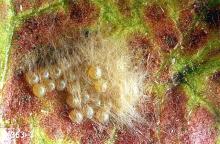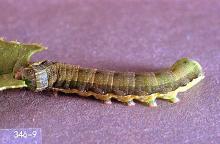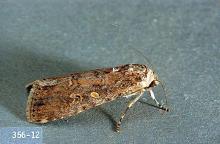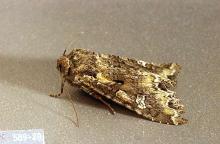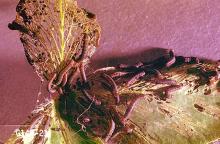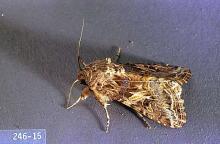Includes
Beet armyworm (Spodoptera exigua)
Bertha armyworm (Mamestra configurata)
Western yellowstriped armyworm (Spodoptera praefica)
Pest description and crop damage Larvae vary in size and color; usually they are 1.5 to 2 inches long at maturity. Armyworms are pests of most legume hay crops. See: https://www2.ipm.ucanr.edu/agriculture/alfalfa/ for additional information.
Management-chemical control
- alpha-cypermethrin (Fastac EC) at 0.0175 to 0.025 lb ai/A. PHI 3 days of cutting or grazing. REI 12 hr. Retreatment interval 7 days. Do not exceed 0.025 lb ai/cutting and 0.075 lb ai/A per season. This product is highly toxic to bees exposed to direct treatment or residues on blooming crops or weeds. Do not apply this product or allow it to drift to blooming crops if bees are visiting the treatment area. (Group 3A)
- azadirachtin (Aza-Direct, Neemix 4.5, other products)-See specific labels for rates. PHI 0 days. REI 4 hr. Aza-direct and Neemix 4.5 are OMRI-listed for organic use.
- Bacillus thuringiensis (numerous products) at 0.25 to 1.5 lb product/A. PHI 0 days. REI 4 hr. Most effective on small caterpillars; use highest recommended rate for more mature caterpillars. Evening applications increase efficacy. A spreader-sticker may improve performance. Some formulations are OMRI-listed for organic use. (Group 11)
- beta-cyfluthrin (Baythroid XL) at 0.0125 to 0.022 lb ai/A. PHI 7 days for grazing or cutting. Only effective on small larvae. REI 12 hr. Retreatment interval 5 days. Do not exceed 0.044 lb ai/A per cutting or 0.175 lb ai/A total per season. This product is highly toxic to bees exposed to direct treatment or residues on blooming crops or weeds. Do not apply this product or allow it to drift to blooming crops if bees are visiting the treatment area. (Group 3A)
- carbaryl (numerous products) at 1 to 1.5 lb ai/A. PHI 7 days for grazing or cutting. REI 12 hr. Do not apply more than once per cutting. Carbaryl may burn or yellow hay under some conditions, and applying to wet foliage or during high humidity may injure tender foliage. Carbaryl is highly toxic to bees exposed to direct treatment or residues on blooming crops or weeds. Do not apply carbaryl or allow it to drift to blooming crops if bees are visiting the treatment area. Latex-based formulations, such as Sevin XLR Plus, are less hazardous to bees. (Group 1A)
- chlorantraniliprole (Coragen, Prevathon) at 0.045 to 0.098 lb ai/A. PHI 0 days. REI 4 hr. Do not exceed 0.2 lb ai/A or 4 applications per year or 1 application per cutting. Chlorantraniliprole is considered a low risk to bees. Retreatment interval 3 days. (Group 28)
- chlorantraniliprole/lambda-cyhalothrin (Besiege) at 0.049 to 0.078 lb ai/A. PHI 1 day for forage and 7 days for hay. REI 24 hr. Minimum of 5 days between applications. Do not exceed 0.12 lb ai of products containing lambda-cyhalothrin or 0.2 lb ai of chlorantraniliprole-containing foliar products per acre per growing season. Refer to product labels for application limits if products containing gamma-cyhalothrin and products containing lambda-cyhalothrin are to be used in the same season. Because of the pyrethroid component (lambda-cyhalothrin), this product is highly toxic to bees exposed to direct treatment or residues on blooming crops or weeds. Do not apply this product or allow it to drift to blooming crops if bees are visiting the treatment area. (Groups 28 and 3A)
- Chromobacterium subtsugae (Grandevo) at 0.3 to 0.9 lb ai/A per 100 gal. PHI 0 days. REI 4 hr. OMRI-listed for organic use. (Unidentified Mode of Action group)
- cyfluthrin (Tombstone) at 0.025 to 0.044 lb ai/A. PHI 7 days for grazing or cutting. Only effective on small larvae. REI 12 hr. Retreatment interval 5 days. Do not exceed 0.088 lb ai/A per cutting or 0.35 lb ai/A total per season. This product is highly toxic to bees exposed to direct treatment or residues on blooming crops or weeds. Do not apply this product or allow it to drift to blooming crops if bees are visiting the treatment area. (Group 3A)
- gamma-cyhalothrin (Declare) at 0.01 to 0.015 lb ai/A. PHI 1 day for forage harvest or 7 days for hay harvest. REI 24 hr. Do not exceed 0.015 lb ai/A per cutting or 0.06 lb ai/A per season. Refer to product labels for application limits if products containing gamma-cyhalothrin and products containing lambda-cyhalothrin are to be used in the same season. This product is highly toxic to bees exposed to direct treatment or residues on blooming crops or weeds. Do not apply this product or allow it to drift to blooming crops if bees are visiting the treatment area. (Group 3A)
- GS-omega/kappa-Hxtx-Hv1a (Spear Biological) at 0.8 lb ai/A. PHI 0 days. REI 4 hr. Do not exceed 2 lb ai/A per year.
- indoxacarb (Steward) at 0.065 to 0.11 lb ai/A for beet armyworm and 0.09 to 0.11 lb ai/A for western yellowstriped armyworm. PHI 7 days for grazing or cutting. REI 12 hr. Do not exceed one application per cutting or 0.44 lb ai/A per season. This product is highly toxic to bees exposed to direct treatment or residues on blooming crops or weeds. Do not apply this product or allow it to drift to blooming crops if bees are visiting the treatment area. (Group 22A)
- lambda-cyhalothrin (Warrior II) at 0.02 to 0.03 lb ai/A. PHI 1 day for forage harvest or 7 days for hay harvest. REI 24 hr. Apply only to pure stands. Do not apply when bees are actively foraging. Do not exceed 0.03 lb ai/A per cutting or 0.12 lb ai/A per season. Refer to product labels for application limits if products containing gamma-cyhalothrin and products containing lambda-cyhalothrin are to be used in the same season. This product is highly toxic to bees exposed to direct treatment or residues on blooming crops or weeds. Do not apply this product or allow it to drift to blooming crops if bees are visiting the treatment area. (Group 3A)
- malathion (numerous products) at 1 to 1.25 lb ai/A. PHI 0 days. REI 12 hr. Not effective below 65°F. Not effective after worms reach lengths over 0.375 inch. Retreatment interval 14 days. Limit to 2 applications per cutting. Malathion is highly toxic to bees exposed to direct treatment or residues on blooming crops or weeds. Do not apply malathion or allow it to drift to blooming crops if bees are visiting the treatment area. (Group 1B)
- methomyl (Lannate LV; other products) at 0.45 to 0.9 lb ai/A. PHI 7 days for grazing or cutting. REI 48 hr. Do not exceed 10 applications or 3.6 lb ai/A per season. This product is highly toxic to bees exposed to direct treatment or residues on blooming crops or weeds. Do not apply this product or allow it to drift to blooming crops if bees are visiting the treatment area. (Group 1A)
- methoxyfenozide (Intrepid 2F) at 0.06 to 0.12 lb ai/A. PHI 0 days graze/forage, 7 days hay. REI 4 hr. Do not apply more than once per cutting. Do not apply more than 0.5 lb ai/A per year. (Group 18)
- permethrin (numerous products) at 0.05 to 0.2 lb ai/A. PHI 0 days at 0.1 lb ai/A or less, 14 days at more than 0.1 lb ai/A. REI 12 hr. Do not exceed 0.2 lb ai/A per cutting. Retreatment interval 30 days. Permethrin is highly toxic to bees exposed to direct treatment or residues on blooming crops or weeds. Do not apply permethrin or allow it to drift to blooming crops if bees are visiting the treatment area. (Group 3A)
- spinosad (Entrust SC) at 0.031 to 0.063 lb ai/A. PHI 0 days forage; 3 days hay or fodder. REI 4 hr. Do not exceed 0.186 lb ai/A per season. Do not exceed 6 applications per season. Entrust is OMRI-listed for organic use. This product is toxic to bees exposed to treatment for 3 hours following treatment. Do not apply this pesticide to blooming, pollen-shedding or nectar-producing parts of plants if bees may forage on the plants during this time period. (Group 5)
- zeta-cypermethrin Mustang at 0.035 to 0.05 lb ai/A, or Mustang Maxx at 0.0175 to 0.025 lb ai/A. PHI 3 days for cutting or grazing, 7 days for harvesting seed. REI 12 hr. Retreatment interval 7 days. Do not use more than 0.1 lb ai/A per cutting or more than 0.3 lb ai/A per season (Mustang) or 0.05 lb ai/A per cutting or 0.15 lb ai/A per season (Mustang Maxx). These products are highly toxic to bees exposed to direct treatment or residues on blooming crops or weeds. Do not apply this product or allow it to drift to blooming crops if bees are visiting the treatment area. (Group 3A)

